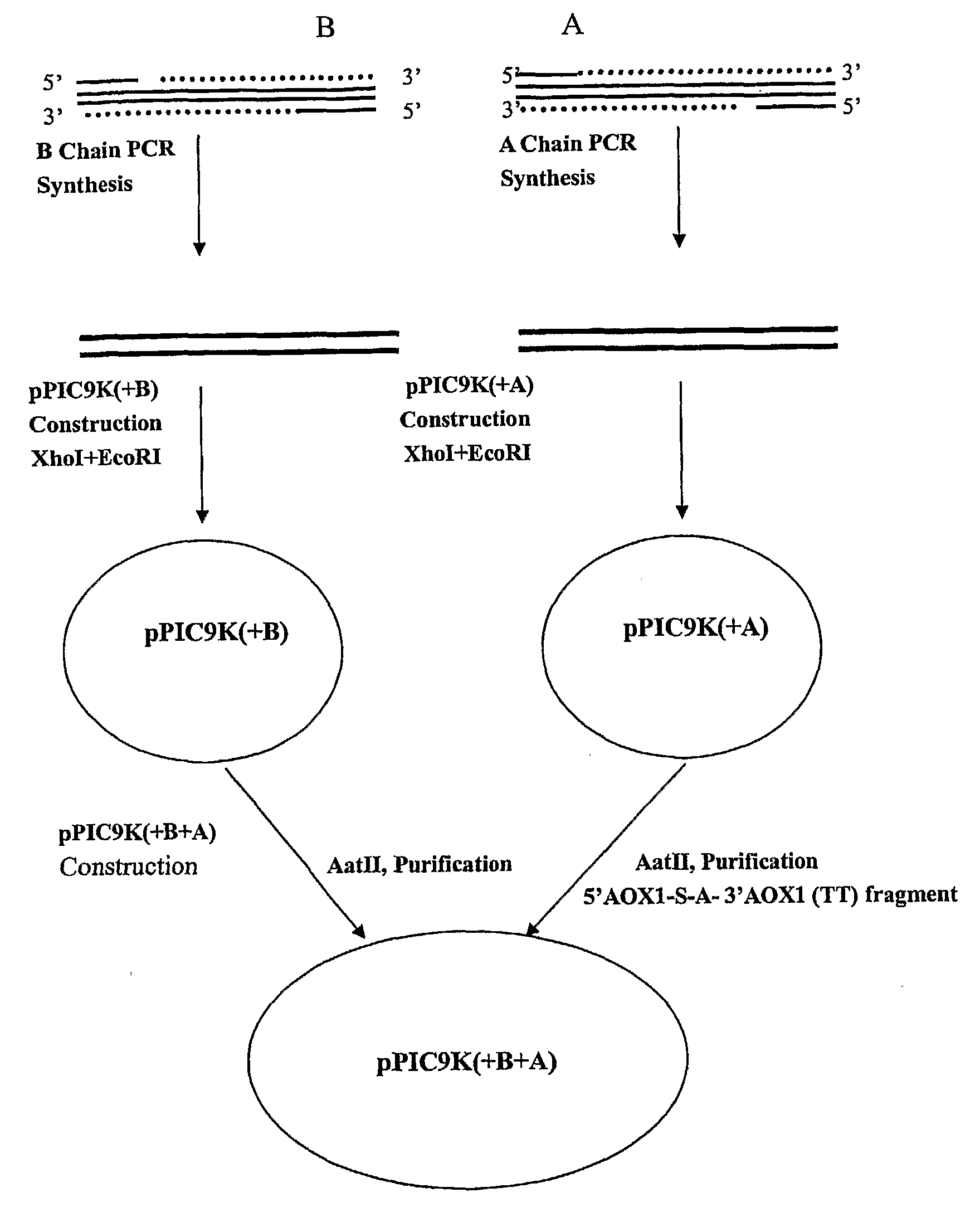Co-expression of multiple protein chains or subunits
- Summary
- Abstract
- Description
- Claims
- Application Information
AI Technical Summary
Benefits of technology
Problems solved by technology
Method used
Image
Examples
example 1
[0075]In order to produce a bioactive human insulin comprising an A chain and a B chain, a recombinant DNA expression vector was constructed to include two expression cassettes to be expressed in a yeast host. The vector was a yeast shuttle vector called pPIC9K, a portion of which was constructed with the following formula:
Pm-Ld-Pt-Y1-Tm-Pm-Ld-Pt-Y2-Tm,
where Y1 is the coding sequence for A chain or B chain while Y2 is for the other chain of human insulin. Because the intended host was methylotrophic yeast P. pastoris, yeast preferential codons were used for Y1 and Y2, and other yeast elements were used to make the above formula as follows:
AOX1 Pm-yeast Ld (S)-Kex2 site-Y1-AOX1Tm-AXO1 Pm-yeast Ld (S)-Kex2 site-Y2-AOX1 Tm.
where the yeast Ld sequence translates into the signal sequence (pre) followed by the pro sequence. At the carboxy terminal of the pro sequence is the short sequence of “Lys-Arg” (“Kex2 site”) which is recognized by endoprotease Kex2 for cleavage.
[0076]1. Vector Cons...
example 2
[0113]This example describes an alternative method for constructing the recombinant expression vector pPIC9K(+B+A). Specifically, the step of constructing the intermediary vector pPIC9K(B-C′-A) in Example 1 is omitted. This example is described to highlight its differences from Example 1. Recitations of similarities are hereby omitted.
[0114]Based on yeast preferential codon for human proinsulin depicted in FIG. 1, a DNA fragment encoding the B chain of human insulin is obtained as follows: Two oligonucleotides are each designed to anneal to an end of B chain's coding sequence:
5′-Oligo (71 nt) (SEQ ID NO:14):5′-GCTACTCGAGAAAAGATTCGTTAACCAACACTTGTGTGGTTCTCACTTGGTTGAAGCTTTGTACTTGGTTT-3′3′-Oligo (70 nt) (SEQ ID NO:15):5′-TAGCGCGGCCGCTTAAGTCTTTGGAGTGTAGAAGAAACCTCTTTCACCACAAACCAAGTACAAAGCTTCA-3′
[0115]The last twenty nucleotides (underlined) at the 3′ end of each of the two oligonucleotides, SEQ ID NOS:14 and 15, are complementary to each other. Similar to the oligonucleotides depicted in ...
example 3
[0122]Similar to protocols illustrated by Examples 1 and 2, an expression vector, e.g., a yeast vector, can be constructed to include two separate expression cassettes for the purpose of expressing and assembling in vivo two subunits of a heterodimer, in this case, IL-12. Specifically, one expression cassette is constructed to include the coding sequence for p35 of IL-12, and the other to include the coding sequence for p40 also of IL-12.
[0123]The same carrier vector and host organism can be used for the purpose of making IL-12. Basically, one may modify Example 1 and 2 to produce IL-12 by simply substituting the coding sequence for p35 for its counterpart for the B chain of human insulin, and then the coding sequence for p40 for its counterpart for the A chain of human insulin. Details of such modification are well within the knowledge of one skilled in the art.
[0124]Each of the patent documents and scientific publications disclosed hereinabove is incorporated by reference herein f...
PUM
| Property | Measurement | Unit |
|---|---|---|
| Length | aaaaa | aaaaa |
| Strain point | aaaaa | aaaaa |
| Bioactive | aaaaa | aaaaa |
Abstract
Description
Claims
Application Information
 Login to View More
Login to View More - R&D
- Intellectual Property
- Life Sciences
- Materials
- Tech Scout
- Unparalleled Data Quality
- Higher Quality Content
- 60% Fewer Hallucinations
Browse by: Latest US Patents, China's latest patents, Technical Efficacy Thesaurus, Application Domain, Technology Topic, Popular Technical Reports.
© 2025 PatSnap. All rights reserved.Legal|Privacy policy|Modern Slavery Act Transparency Statement|Sitemap|About US| Contact US: help@patsnap.com



